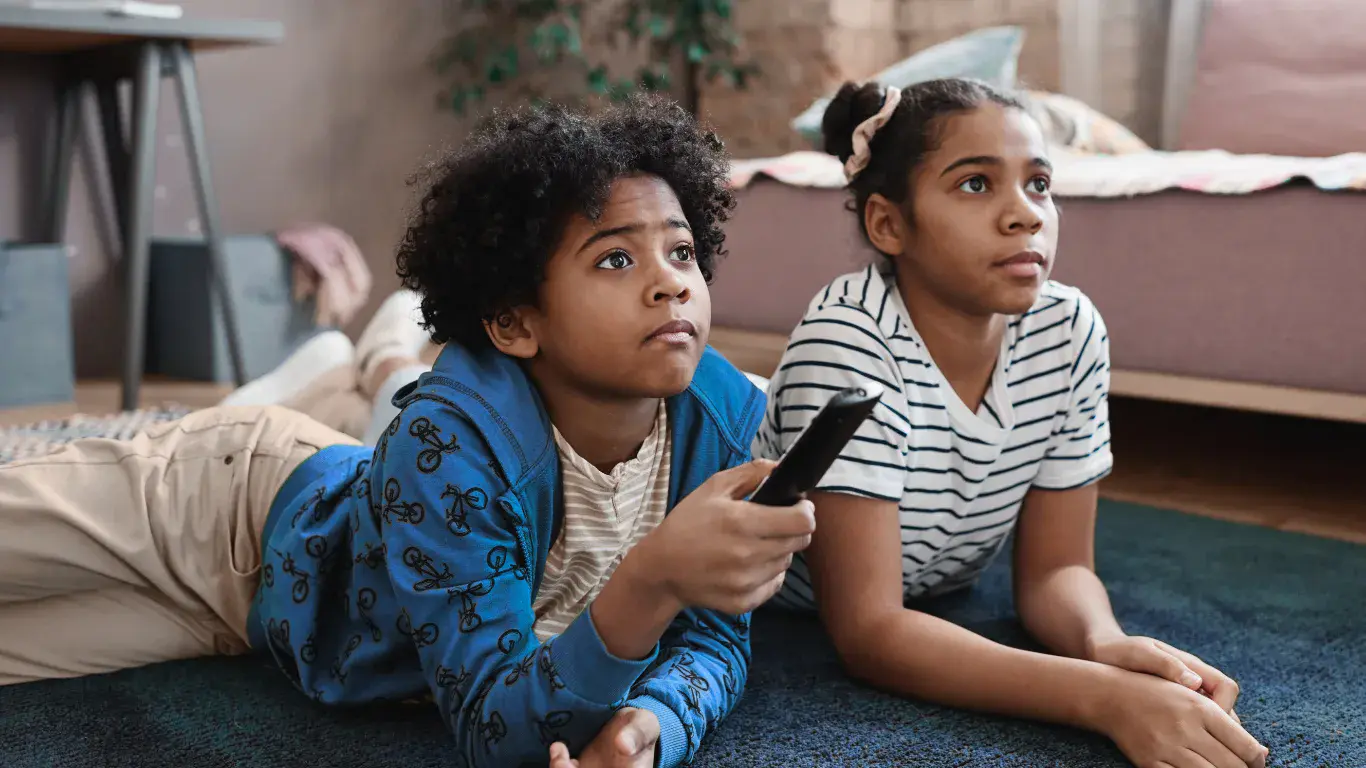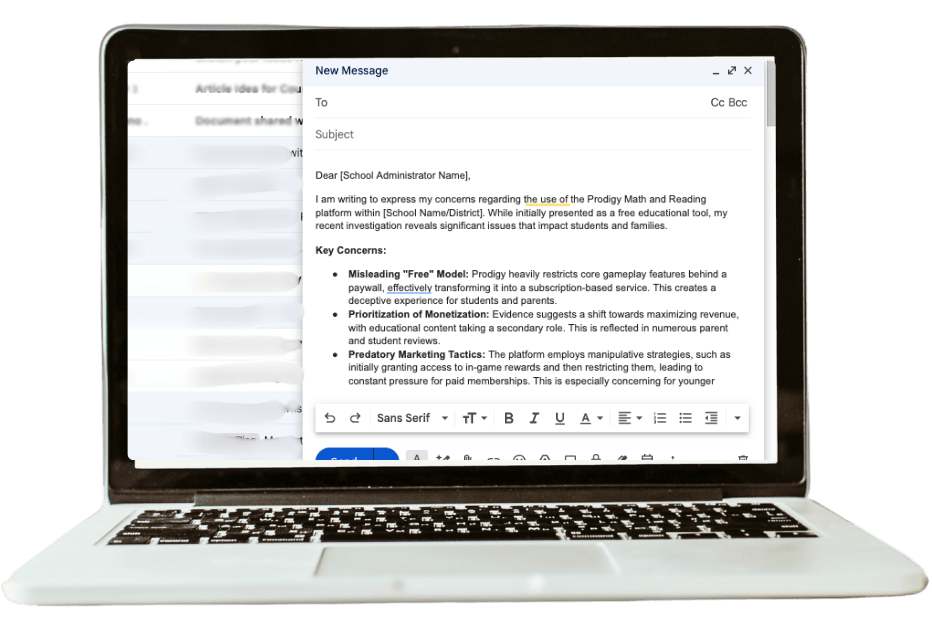Discussions on screen time use for kids often focus on healthy amounts and time limits. But what about the device itself? Is one form of media better or worse than another? Can we promote healthier screen time by choosing televisions over tablets?
The type of media you choose to offer your kids can absolutely work for you, or against you, in your overall screen time goals.
Tablets, phones, video games, and any screen that is hand-held is referred to as “interactive media”, while television is considered “passive media”. Katherine Martinko, author of “Childhood Unplugged: Practical Advice to Get Kids Off Screens and Find Balance”, explains the differences and argues that TV may actually help families achieve healthier screen limits.
Television often carries a bad reputation for causing children to “zone out”. Many parents prefer to offer interactive media because they believe it at least offers some benefits to balance the negatives. However, some research and a closer look prove otherwise.
5 reasons to swap tablets for TVs
1. Accessibility and portability encourage more use
When the screen our child loves can be tossed in a purse or carried in our pockets, suddenly we find ourselves bringing it with us more places. First, it helped us conquer the grocery store, then the restaurant, and suddenly we are handing it to our kids at the park or the pool.
The permanent placement of our TVs enforces natural limits for kids and parents that organically decrease overall daily screen time.
2. Television offers parents more control
Tablets offer a wide variety of options. This can be problematic in two ways.
Encourages low frustration tolerance
Kids can independently jump from one game or activity to another at their own discretion. This is partially why tablets typically hold kids’ attention longer than TV does. Dr. Charlotte Armitage, founder of No Phones at Home Day, explains in an interview, “These apps and short-form videos are designed to encourage engagement and to keep the user glued to the screen. They do this by feeding the user content that they believe the user wants, and they do this rapidly to keep attention.”
When kids begin to feel frustrated or bored with one thing, they can simply hop to another. This type of immediate gratification and fast-paced interaction with screens is linked to more consequences to children’s developing attention skills.
In her interview with Good Morning America, Dr. Zee explains plainly that, “overstimulation can wire children’s brains to crave constant novelty, making it harder for them to focus on quieter, sustained activities like independent play or reading”.
In contrast, when television shows get boring, younger children who cannot yet use a remote have to ask an adult for something new or problem-solve by finding a new activity. Parents can more easily monitor their engagement and regulate accordingly.
Lack of oversight on content consumption
Parents do not always know what a child is viewing or interacting with on a handheld device. Television in communal spaces allows for full transparency and parent oversight. This means parents can easily monitor what their child is watching and ensure it is appropriate for their age and developmental capabilities.
Ensuring children only have access to media appropriate to their age is crucial to creating tech habits at home that protect their health and well-being.
3. Handheld devices are harder to take away
Think about the general posture of a child when using a tablet versus watching television. They are hunched over, looking down, eyes less than 6 inches away from the screen, and maybe wearing headphones. They can easily block out the rest of the room and the world around them.
When we approach them to end screen time and remove the device, we are encroaching on their bubble. We are also interrupting a dopamine release pattern that biologically can leave them feeling grumpy and angry.
We also have the added stressor of needing to physically remove it from their hands. While a television can be turned off despite protest, a tablet or phone needs to be willingly handed back. Kids have more control in the dynamic of ending screen time on a handheld device than on a TV. For some parents, this can lead to more difficulty enforcing screen time limits.
4. Handheld devices impact vision
Generally, when children watch television, they are seated several feet away. In contrast, children are positioned only a few inches away from their handheld devices. This proximity puts an extra strain on their developing eyes.
Ayesha Malik, OD, pediatric optometrist at Children’s Hospital of Philadelphia (CHOP), explains four ways that devices can impact vision, including eye fatigue, loss of focus flexibility, dry eyes, and nearsightedness. She highlights that children who spend more time indoors are more likely to develop nearsightedness, as researchers believe that exposure to UV light is imperative to vision development in childhood.
5. Interactive devices are not educational
Particularly for kids preschool-aged and younger, research consistently shows that while children can learn some things from educational tablet or phone games, it is nearly impossible for them to transfer that knowledge to real life. In other words, learning opportunities from interactive media are limited.
Instead, children require real-world experiences to learn. They learn best through face-to-face interactions, human connection, free playtime to explore and create, and time spent outdoors. Therefore, both televisions and tables detract from the essential experiences they need to learn, regardless of whether programming is advertised as “educational”.
Reminders
Television time is still screen time. Like all screens, TV takes away from essential time to play and be outdoors that kids require to develop social emotional skills, cognitive functions, and healthy physical growth.
Monitoring the content of TV programs is of utmost importance to keeping risks low and protecting brain development. Exposure to highly stimulating, violent, or age-inappropriate content can be damaging to mental health and attention in kids, no matter what device they are viewing it on.
Take Aways
Join the movement to choose slow-paced, educational TV programming, particularly for children under age six.
If you are a new parent debating how and when to introduce screen time to your children, consider avoiding handheld devices and interactive media to start. Sticking to TV may help to more easily keep to the AAP recommendations for healthy screen time use in homes.
If you are a parent struggling to enforce screen time limits for your kids on their tablets or interactive devices, consider swapping tablet time for TV time. Rather than continuing to fight the same battle, offer them TV time instead for a few weeks to change up the routines. See if passive programming more naturally decreases their desire for screens, or improves their reactions or behaviors when screen time ends.
If you enjoyed reading this article, please consider sharing it with a friend or leaving a comment. Thanks for visiting!

Authored by: Courtney G. DiStefano, CCLS
Courtney G. DiStefano is a Certified Child Life Specialist, child development expert, and mom of three with nearly fifteen years of clinical experience serving children and families in hospitals and social-service settings.




